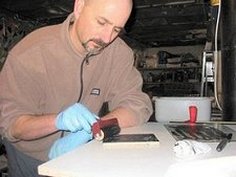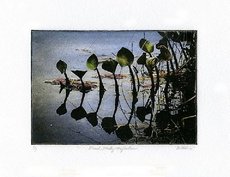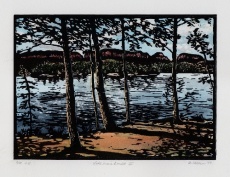Brian Holden
printmaker and visual artist

The Art of Printmaking
My images are derived from a variety of surfaces that employ several types of printmaking techniques. These include serigraphy, relief block, collagraph plate, intaglio plate and photopolymer gravure. It doesn't matter what discipline is employed, for each one will present a set of challenges that force me to think about, learn from and ultimately expand my levels of skill and expertise in that particular medium. Some of the images have incorporated the combination of media, such as the addition of watercolour applied through hand colouring. The computer has also been used as a tool for creating positives in the photo polymer process and also for preparing artwork as a positive to expose onto photo- emulsion coated surfaces that were used in several of the serigraph studies on paper. Polymer plates are a more recent development that marries new technology with traditional printing processes in a safe non-toxic manner.
Serigraph or Silkscreen Print
A form of printing in which a stencil is made on a fine mesh fabric screen that acts as a support. The stencil can be made from a number of materials including paper; hand cut transparent films, painted on liquid resists and more recently light sensitive emulsion coatings which allow one to produce high contrast photographic derived images. Ink is passed through open areas of the stencil which is deposited on paper below using a sharp edge rubber or plastic blade (called a squeegee). Screen printing can have a hard edged quality caused by the crisp edges of the stencil. For a more detailed tutorial on this process, click here.

Relief print
The image is printed from ink rolled with a rubber, plastic or dense foam brayer onto the raised portions of a carved, etched, or cast block. Generally a rigid material such as wood, linoleum is used but other surfaces such as cardboard, styrofoam, plaster, acrylic, vinyl, rubber can be used. Non-printing areas have been cut away. The printing surface stands in relief above the rest of the block and the ink lies on the top of the block and is transferred to the paper under light pressure which is delivered using either hand burnishing (rubbing) with a baren or other flat smooth tool or by passing it under the roller or flat plate of a printing press. Wood engraving is another technique that produces a relief image. For more detailed information on this process, click here. You can also download an in-depth tutorial on Relief Block Printmaking (2.3 Mb).

Intaglio
Refers to a process in which an image that has been cut or etched into the surface of a metal, plastic or board plate made by printing using extreme pressure between the plate surface and paper. Ink is forced into lines and textures in a plate, after which the top surface of the plate is wiped clean leaving the ink in the recessed areas. This ink is then pressed onto printing paper though the use of an etching press. Intaglio process can incorporate the following techniques including drypoint, hard and soft ground etching, sugar lift, mezzotint and aquatint and also recently the use of less toxic mordants such as ferric chloride (a salt based chemical) and light sensitive polymer plate.
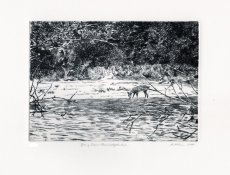
Photopolymer
This technique is relatively recent and is a non-toxic alternative to the traditional acid bitten plate type of etching. It is basically a thin steel plate prepared with a light-sensitive polymer surface. It works like a photograph: A transparency is placed on the plate and exposed to a light source. Everywhere light touches the plate, the polymer hardens while unexposed areas remain soft and water-soluble. The plate once exposed, is developed in a water bath that rinses away unexposed areas. A final exposure to the sun or in an UV light exposure unit hardens the final image. The plate can then be inked and printed (preferably with a press) in the usual fashion. Plates can also be used for relief printing. For a more detailed tutorial on this process, click here.
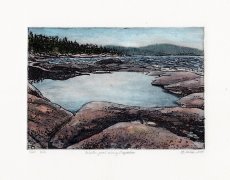
Collagraph
A collagraph print is best described as a collage printmaking technique, where the image is composed from a variety of textured materials glued to a substrate and printed either in an intaglio or relief fashion. For a more detailed tutorial on this process, click here.

For an understanding of the creative process, and images of works in progress,visit my blog at My Printmaking Journey.You can also view more of my earlier work at my archive website.
